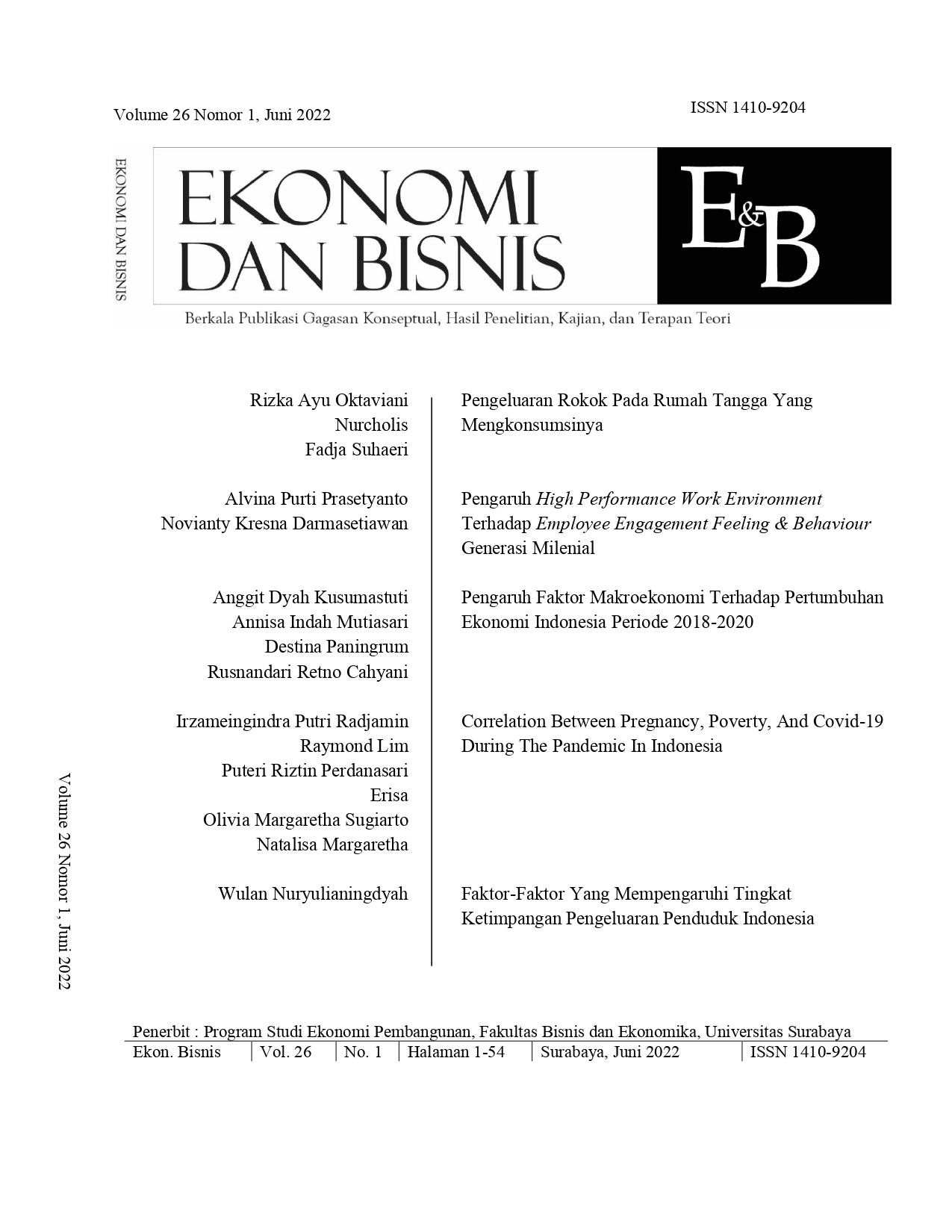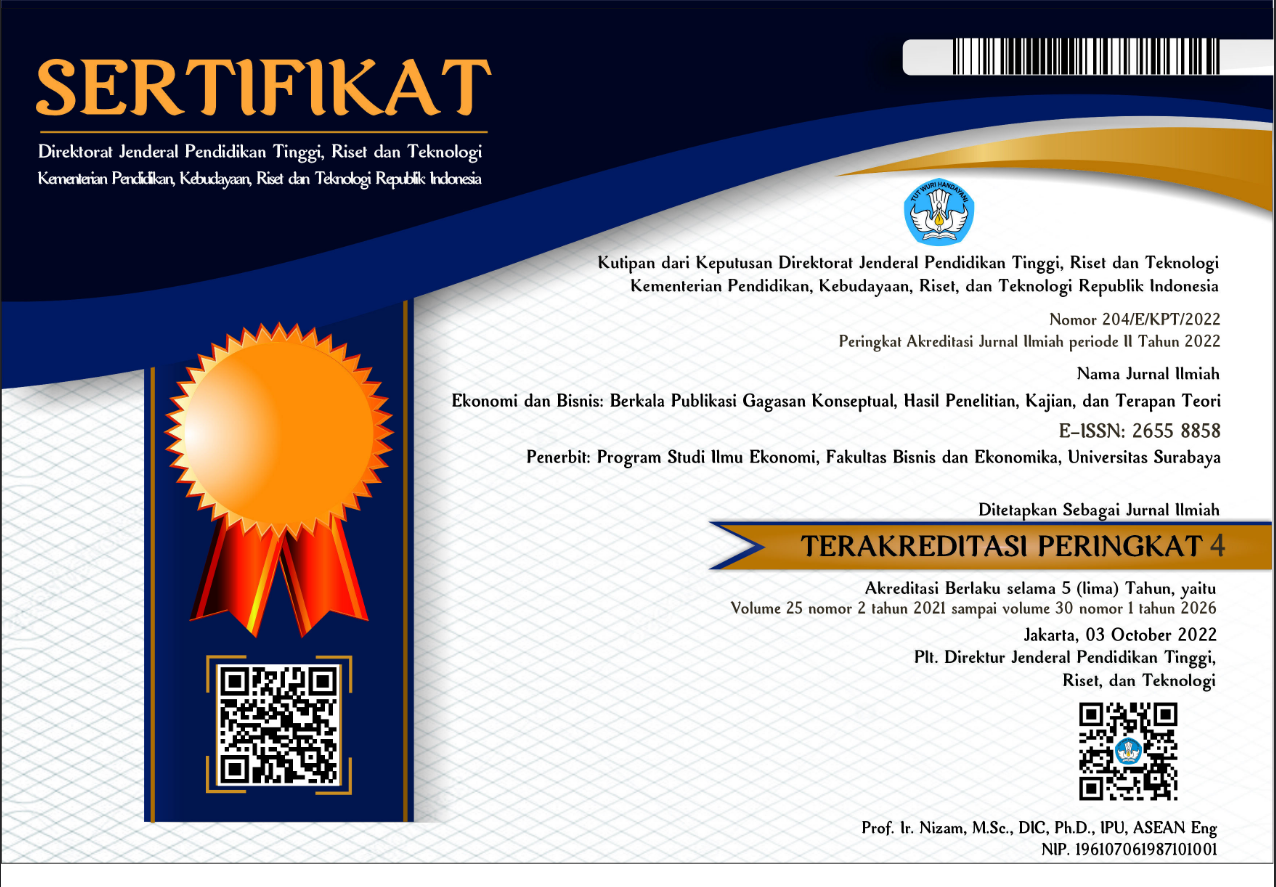FAKTOR YANG MEMPENGARUHI TINGKAT KETIMPANGAN PENGELUARAN PENDUDUK INDONESIA
 Abstract Views:
1264 times
Abstract Views:
1264 times
 Nuryulianingdyah (Bahasa Indonesia) Downloads:
1155 times
Nuryulianingdyah (Bahasa Indonesia) Downloads:
1155 times
Abstract
This study aims to analyze the inequality of population spending in Indonesia. The variables used are HDI, percentage of poor people, TPT, and GRDP per Capita and investment. This study uses multiple regression analysis, Spatial Autoregressive (SAR) Model, and Spatial Error Model (SEM). The criteria for the goodness of the model used is to compare the R2 and AIC values of the two models. The best models are those with higher R2 and lower AIC than other models. This study concludes that the distribution pattern of the Gini ratio in Indonesia appears to be clustered between adjacent areas. Based on the relationship between the Gini ratio and HDI, the percentage of poor people, TPT, GRDP per capita, and investment, it can be interpreted that the similarities and differences in characteristics in each adjacent province can lead to an increase or decrease in the Gini ratio/level of expenditure inequality in Indonesia. The SEM regression model is better than the OLS regression model in determining the factors that influence the level of expenditure inequality in Indonesia because there is a spatial dependency on the dependent variable. In the SEM model, the variables that have a significant effect on the Gini ratio are HDI, percentage of poor people, and investment.
Downloads
References
Anselin L. (1988). Spatial Econometrics: Methods and Models. Dordrecht: Kluwer Academic Publishers
Alaa, R. D., & Sutikno, S. (2019). Pemodelan Faktor-Faktor yang Memengaruhi Gini Rasio Pembangunan di Jawa Timur dengan Regresi Spasial. Jurnal Sains dan Seni ITS, 7(2), 265-272. https://doi.org/10.12962/j23373520.v7i2.36635
Badan Pusat Statistik. (2019). Berita Resmi Statistik Tingkat Ketimpangan Pengeluaran Penduduk Indonesia Maret 2019, Badan Pusat Statistik, Jakarta.
Badan Pusat Statistik, (2019). Statistik Kriminal 2019, Badan Pusat Statistik, Jakarta.
Badan Pusat Statistik, (2020), Statistik Indonesia 2020: Penyedia Data untuk Perencanaan Pembangunan, Badan Pusat Statistik, Jakarta.
Bank Dunia, (2016), Ketimpangan Yang Semakin Lebar, Bank Dunia, Jakarta
Bappenas, (2017), Metadata Indikator Tujuan Pembangunan Berkelanjutan (TPB)/ Sustainable Development Goals (SDGs) Indonesia: Pilar Pembangunan Ekonomi, Bappenas, Jakarta
Bappenas, (2017), Lampiran Pidato Kenegaraan Presiden Republik Indonesia: Dalam Rangka HUT ke-72 Proklamasi Kemerdekaan Republik Indonesia, Di Depan SIdang Bersama DPD RI dan DPR RI.
Bappenas, (2019), Dampak Ekonomi dan Skema Pembiayaan Pemindahan Ibu Kota Negara, dalam Dialog Nasional II: Menuju Ibu Kota Masa Depan: Smart, Green and Beautiful pad aRabo, 26 Juni 2019
Bayhaqi, R. (2018), Analisis Ketimpangan Pendapatan Penduduk di Kalimantan Barat Tahun 2010-2015, Skripsi, Universitas Islam Indonesia, Yogyakarta
Infid, (2018), Laporan Surey Persepsi Warga Mengenai Pelaksanaan Tujuan Pembangunan Berkelanjutan, Infid, Jakarta
Kutner, M.H., Nachtsheim, C.J., & Neter, J. (2004). Applied Linear Regression Models. Fourth Edition.New York: McGraw-Hill Companies, Inc.
Putri, Y. E., Amar, S., & Aimon, H. (2015). Analisis faktor-faktor yang mempengaruhi pertumbuhan ekonomi dan ketimpangan pendapatan di Indonesia. Jurnal Kajian Ekonomi, 3(6).
Wilkilson, R dan Pickett, K. (2009), The Spirit Level “Why Greater Equality Makes Societies Stronger”, Bloomsburry Press, New York.

 DOI:
DOI:















